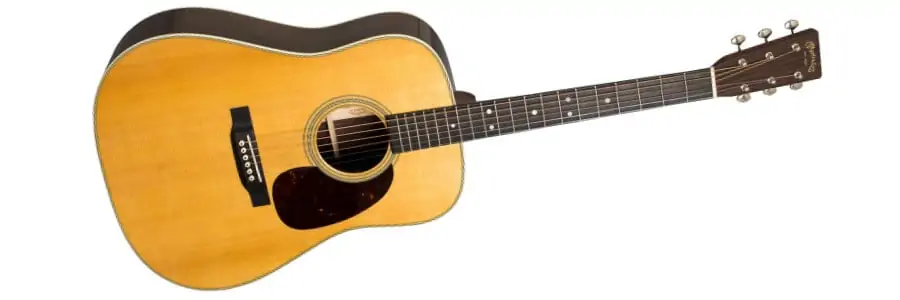Acoustic guitars have been around for centuries. Interestingly enough, people rarely put their guitars on scales looking to find their guitar’s weight. Here, I will try to go through all of the possible cases, as well as materials and variations that may have an impact on the weight of the guitar.
How much does an acoustic guitar weigh? Most regular size acoustic guitars will weigh between 2.5 lbs and 5 lbs (between 1.1 kg and 2.2 kg). The regular size acoustic guitars can be divided into several types of guitar:
- Parlor\Tenor weighs a bit over 2 lbs (0.9 kg).
- Concert and Grand Concert weigh around 3-5 lbs (1.3 – 2.2 kg).
- Auditorium and Grand Auditorium weigh around 4-5 lbs (1.8 – 2.2 kg).
- Dreadnought weights can weigh from 5-6 lbs (2.2 – 2.7 kg).
- Jumbo and Grand Jumbo weigh over 6 lbs (2.7 kg).
A full-scale travel guitar weight 5-10 lbs (2.25 – 4.5 kg).
Mini acoustic guitar around 2-5 lbs or even less (0.9 – 2.2kg).
There are several factors that can impact the weight are the type of wood, pickups type, size of the guitar, and build quality which I will explain in the following sections.
What Affects Acoustic Guitar Weigh

Among the most important factors is the size of the guitar. Acoustic guitars come in various shapes and sizes, and it can have a major impact on the instrument’s weight. So, let’s start with the smallest ones. One of the smallest acoustics is one-quarter the size of a regular one. Needless to say, it will be the lightest one on the list. These guitars usually aren’t master crafted, and they are meant for children who are just starting their musical journey.
If you are considering to start playing guitar and looking for an acoustic guitar on a budget and to save you time searching I made the following post Top 20 Budget Acoustic Guitars Under $100, $150, $200, $300 For Beginners
Full-size Acoustic Guitar Weight
Now, our main focus should be full-sized guitars, since they are the most common ones, and are something that most people are looking to buy. Besides, they won’t act as a transition guitar which you will use for practice and change it as soon as you (or your child) grow up.
If we take a look at full-size guitars, there are still variations here since there is no standard for the size of an instrument. Naturally, dimensions will vary from manufacturer to manufacturer, but there are some generally accepted terms for describing the type of acoustic guitar.
- Traveler and mini – These are previously mentioned instruments that are shorter in scale and size compared to the regular ones. Usually, the price and quality are quite lower, and the weight of the instrument is perfect for carrying it around. It can be less than 2 lbs (1 kg)
- Parlor and tenor – Parlor guitars were incredibly popular at the beginning of the 19th century. They are smaller than the regular ones, but the price is a lot higher. It is suitable for any skill level. Tenor guitar, on the other hand, is not really a regular guitar. It has four strings instead of six, and it is tuned CGDA. Naturally, the body size is smaller and the neck is thinner since there is no need for six strings. These will weigh over 2 lbs.
- Concert and Grand Concert – Sometimes companies won’t make a clear distinction between the two. The difference between the two is maybe a couple of inches, and it is good for both beginners and for recording. Concert guitars are in a weight-range of around 3-5 lbs.
- Auditorium and Grand Auditorium – Auditorium is a mid-sized guitar and sometimes, the companies will make no distinction between auditorium and orchestra. The same applies to the Grand Auditorium and Auditorium. It is one of the most common sizes, and the difference is only in a few inches. The weight of the auditorium is around 4-5 lbs.
- Dreadnought – This type originated at the beginning of the 20th century. Martin started creating Dreadnought guitars, and many manufacturers followed. The body of these guitars is much larger than the Grand Auditorium, for example. It is currently the most popular shape. The guitar itself is not really beginner-friendly, and it’s most commonly used by more experienced musicians. Dreadnoughts can weigh from 5 to over 6 lbs. Naturally, there are models that are over or under this number, but this is the most common one.
- Jumbo and Grand Jumbo – Finally, jumbo guitars are as big as it gets. Grand Jumbo is only slightly wider, and it will be rather difficult to find anything bigger than these models. The weight can be the highest one on the list and it is over 6 lbs.
Full-Scale Travel Guitar Weight
If you are not interested in carrying a full-size guitar, there is still an option to keep the scale length, while getting an instrument that’s easy to carry. To achieve this, the scale length (or the distance from the nut to bridge) is the same. However, the difference is usually in the size of the body. This way, the guitar will be easier to store, and you can travel with them as much as you like.
Needless to say, the quality of the sound will suffer, and that’s the main reason why you’ll never see a performer with a travel guitar. But if you are looking to pass the time or something that you can play in a hotel, this might be your best option. A perfect example of the travel guitar is the Voyage Air Transit series that weighs around ten pounds (or 4.8 kg). What’s unique about this model is that you can fold it in half! Another option for travel guitars is different body sizes but with the same scale length like ¾ or similar.
Mini Size Acoustic Guitar Weight
Since it is designed to serve as a stepping stone only, the company will rarely use high-quality materials which are often heavier, but more on that later. It is important to notice that ¼ guitar is not really one-quarter of the size, but rather a guitar with a shorter neck and body length. They usually have a scale of around 19 inches (48 cm). The total length is approximately 31 inches (78 cm). They can weigh around 2 pounds, or even less based on the materials used.
The next one on the list is a half-size guitar. Once again, if you put two of these on top of each other, you won’t get the size of a regular guitar. Similar to quarter one, the half-size guitar is smaller, and it’s designed for beginners and children. They are also great if you want to have a traveling guitar that won’t take too much space. Usually, they are around 2 pounds in weight, and the scale is a couple of inches shorter. Half-size guitars can be 30 inches long.
Naturally, the next one is three quarters, which is a bit smaller than the full-size or four-quarter guitar. As you can imagine, the weight will depend on the size of the guitar, and the full-size one will be the heaviest. Mini guitars weigh around 2-3 pounds, and the scale length is between 28 cm and 40 cm. The overall length of acoustic guitars can vary, and it’s usually between 30 and 40 inches.
You can still find heavier mini guitars that can be even 5 pounds. As previously mentioned, they can have either a full-size scale or lower. Either way, depending on the model and the size of the body.
It is challenging to find a type of guitar and sort them all properly since some manufacturers will make something that others will put in a different category. I mentioned that sometimes there is no difference between Auditorium and Orchestra, and each company has full freedom to create something they like that can be in-between these categories.
There are also hybrid guitars that can be used both as an acoustic or as electric. A perfect example is the renewed acoustasonic series by Fender which has a shape of an electric guitar (Stratocaster or Telecaster) while having a soundbox with a pickup.
If you are interested also in the price of an acoustic guitar then check out my post How Much Does An Acoustic Guitar Cost? (13 Examples)
Types Of Wood

The first and foremost thing is whether the guitar has a laminated tonewood or solid one. Laminated will weigh less, while the solid is obviously heavier. Furthermore, if you have two guitars with identical shapes and every dimension is the same, using different wood will affect the weight.
The reason for this is that each material has a different density. For example,
- maple is 550-700 kg/m3
- rosewood can be from 420 to 940 kg/m3 depending on the type
- mahogany is 450-640 kg/m3
This means that if you find a guitar made of East Indian (830 kg/m3) or Honduran rosewood (940 kg/m3), it will be heavier than the one made of mahogany or maple.
And if you add different shapes to the equation, you can see how the weight of one acoustic can vary a lot. Change in wood and different types apply to every part of the guitar. There is no standard, and the guitar can have a body made of one type of wood, and neck from something else. Usually, guitars have a maple or mahogany neck, while bodies can be something else. But there is no specific rule that dictates the types that manufacturers can use.
Finally, some manufacturers use tops to create more attractive instruments. This means that they can use a certain wood for the soundbox of the guitar, and glue a thinner piece of wood on top of it for the visual effect and a change in tone.
Acoustic Guitar Hardware
When it comes to hardware, all acoustic guitars will have some to a degree. All guitars will have tuning machines, bridges, and even strings that will add to the overall weight of the guitar. The bridge of the acoustic guitar is usually made of wood while tuning machines are always metal. Similar to the previous part, the density of metal will play a small role in the weight of the instrument. Fortunately, there aren’t many metal parts on the guitar and the change in metal will make an almost insignificant change in weight.
It is important to mention that some acoustic guitars will have a pickup. If the guitar is with electronics, that can slightly increase the weight as well by a couple of ounces. While pickup itself is not that heavy, and most guitars use piezo pickups, it is still something we should consider when talking about overall weight. The PIezo pickup is somewhere around 2 oz, and potentiometers are even less. The total increase to the guitar’s weight is probably less than 3.5 oz (100g). Needless to say, the guitar with a pickup can be slightly heavier than the one without it..
Examples Of Acoustic Guitars Weight
Now, let’s take a look at some of the popular models and brands that you can find in your local store, and see how the weight changes between each model.
Martin D-28 Dreadnought
Weight: 4.8 lbs (2.17 kg)
This model is a standard for Martin & Co., and it’s been around for decades. The body of the guitar is Sitka spruce or Adirondack red spruce, the neck is usually mahogany, while the fretboard is made of ebony.
Martin D-15 Dreadnought
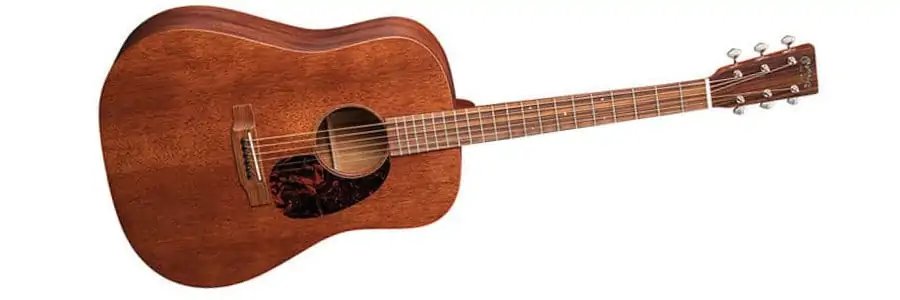
Weight: 3.8 lbs (1.72 kg)
It is a dreadnought model with solid mahogany construction. Usually, it has a beautiful satin finish, and it’s one of the cheaper models by this company.
Yamaha FG830 Dreadnought
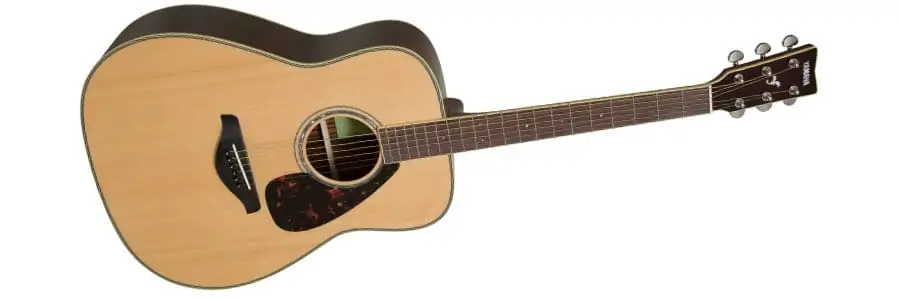
Weight: 4.4 lbs (1.99 kg)
It seems obvious that Martin’s dreadnoughts served as an inspiration for this Yamaha model. Nevertheless, the guitar still offers something new and unique. The guitar comes in many variations from rosewood and maple, to spruce and mahogany.
Yamaha FGX830C Dreadnought
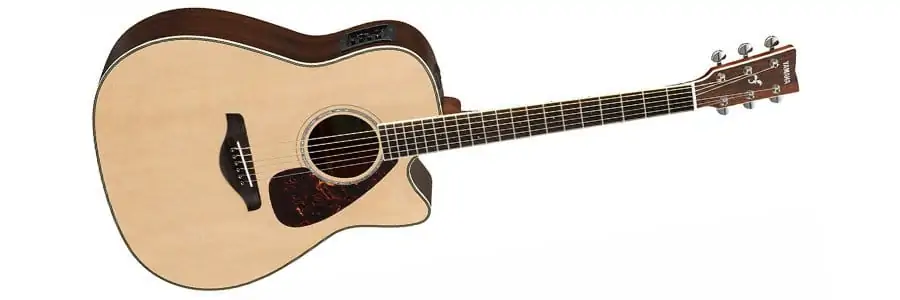
Weight: 5 lbs (2.26 kg)
This Yamaha model has a solid top and a cutaway which makes it perfect for hitting the higher frets. Both quality and design are amazing, and the wood used for this guitar is rosewood and spruce.
Epiphone Masterbilt Dreadnought
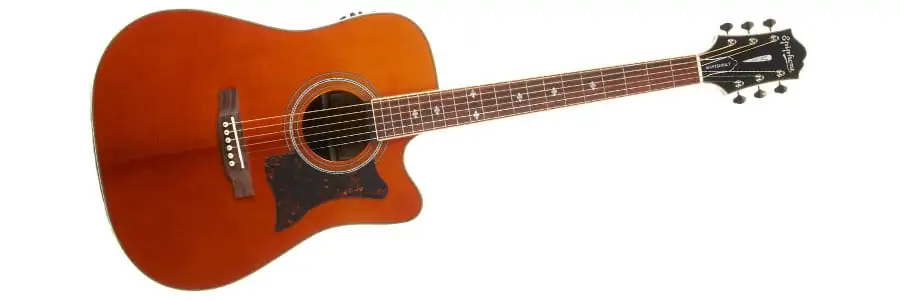
Weight: 5.2 lbs (2.35 kg)
This series by Epiphone followed in Gibson’s steps and offered a more theatrical look. Usually, the wood is mahogany, but you can find other types as well. Similarly to Yamaha, you can find ones with a cutaway.
Fender Acoustasonic Telecaster
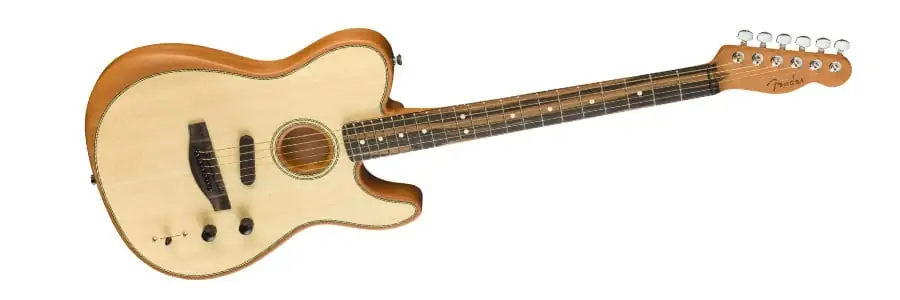
Weight: 4.9 lbs (2.22 kg)
The famous series by Fender managed to create a perfect hybrid between their well-known Telecaster and acoustic guitar. Acoustasonic Telecaster has the same shape as Tele, but with both resonator and a pickup. The guitar is perfect for anyone looking to have a bit of both.
Taylor BT1 3/4
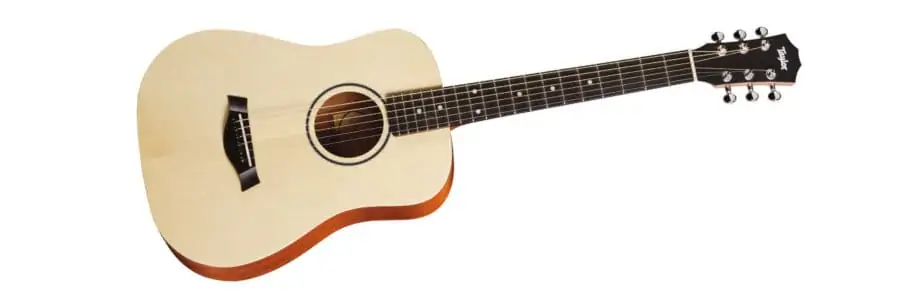
Weight: 2.6 lbs (1.17 kg)
Taylor BT1, or commonly known as Baby Taylor is a smaller model that’s ideal for beginners and children. The scale is ¾ and it has an acoustic guitar shape, without a cutaway.
Gibson J Series Dreadnought
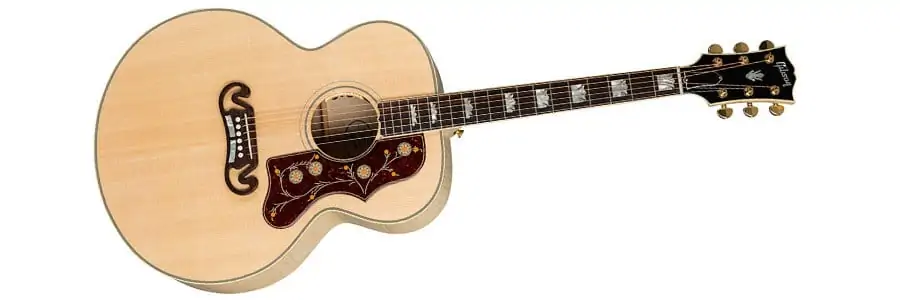
Weight: 3.5 – 4.5 lbs (1.58 – 2.04 kg)
The J series is close to Martin’s price range, and it is a serious professional guitar. With dreadnought size, this model is neither for children nor beginners. However, it is one of the best guitars you can find on the market.
Gibson Dreadnought – Hummingbird Pro
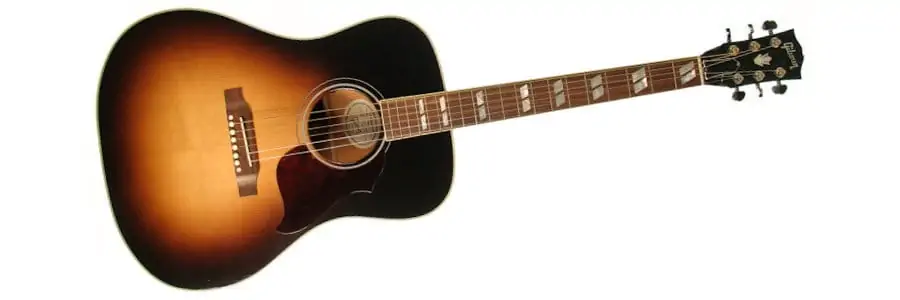
Weight: 4.7 lbs (2.13 kg)
Besides the J series, you can find other even heavier Gibson models like Hummingbird. What’s sure is that you will buy an incredible instrument, from a manufacturer that’s been around for over a century.
Taylor 114ce Sitka Spruce Concert
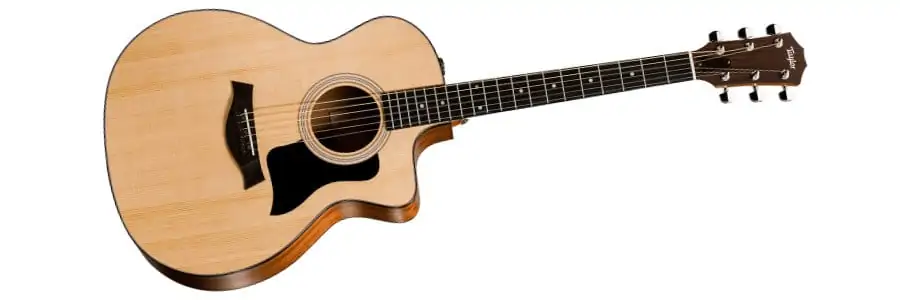
Weight: 4.6 lbs (2.08 kg)
Taylor guitars are excellent for both beginners and intermediate players. This concert model is made of Sitka spruce with walnut. It also has a cutaway, which is something that many players prefer.
Kinscherff High Noon

Weight: 6.5 lbs (2.94 kg)
While not as famous as Martin or Fender, Kinscheriff is an excellent brand that will surely satisfy your musical taste. The guitar comes in several variants like with or without a cutaway, and you can find even different combinations of wood.
Fender Stratacustic
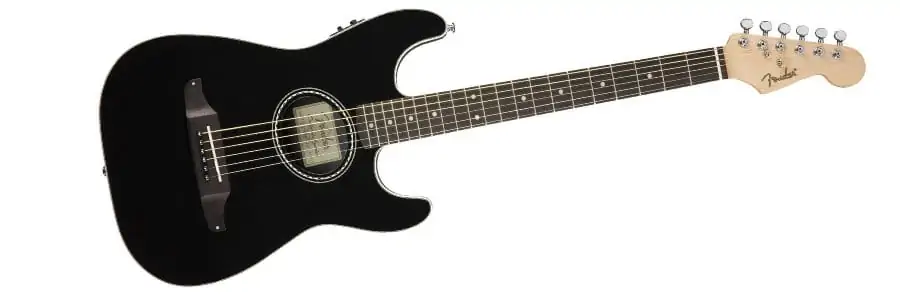
Weight: 9 lbs (4.08 kg)
The sibling of acoustasonic Tele, Stratacustic guitar managed to incorporate one of the most popular shapes into the acoustic guitar. The result is incredible. For all Strat lovers out there, this might be a perfect choice.
Yamaha GL1 guitar

Weight: 2 lbs (0.90 kg)
These guitars are small, easy to carry, and easy to play. What is more important is that they are cheap. You won’t have to spend a fortune on them, and they can easily fit in your car. The best thing is that you can carry them wherever you go.
Voyage Air Transit guitar
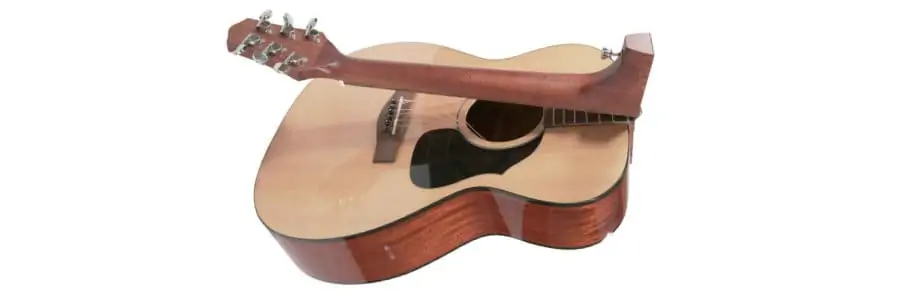
Weight: 10 lbs (4.53 kg)
A full-size guitar that is easy to carry. The reason for this is a unique design that allows the player to fold the guitar in half. Needless to say, the guitar is a lot heavier than a small travel guitar, but it will take a lot less space than the regular model.
If you are interested not only in acoustic guitars weight but also in electric. You can check out my post How Much Does An Electric Guitar Weigh? (12 Examples)
Does Acoustic Guitar Weight Affect The Tone?
You are probably wondering for a while if the weight of the guitar has any impact on the tone. We all know that the sound that comes out of the guitar can be so different depending on the model. The short answer is yes. The weight itself has no impact on the tone whatsoever. But, the weight depends on the type of wood the manufacturer used. The type of wood can make a great impact on the tone, at least for acoustic guitars. The reason for this is that the sound is resonating in the soundbox, and different materials will act differently.
Unlike electric guitars where the sound is “designed” in the pickups and amplifier, an acoustic guitar has to focus on the resonance of the wood. Choosing a different material will create a world of differences in the color of each note that you play on that guitar.
As a result, the weight will change as you change the wood or try out different models. But weight itself will play no part in it. While you might say that guitars with different weight sound different, it is because of the change in material and not the weight itself.
Do Acoustic Guitars Get Lighter With Age?
Yes. The acoustic guitar is almost like a living being and every part of it plays an important role in the creation of sound. People have talked about this for ages, and they agree that acoustic guitars sound different as they get older. The reason for this is as time passes, the wood will age. And as the body of the guitar (and all other parts as well) age, it will become lighter.
Thanks to this aging effect, the instrument can become more responsive and resonant. When you play the guitar, the strings will create insignificant sound by themselves. However, the vibrations will transfer to the bridge of the guitar, and to the top of the soundboard.
Some claim that when you play the guitar a lot, it will loosen the soundboard or the wood, and it will improve the responsiveness of the instrument. Some manufacturers like Yamaha have developed an aging process that can improve the sound of a new instrument, and make it sound more in line with the vintage models.
Of course, this is difficult to prove, and there is no guarantee that the guitar will improve over time. Bad sounding instruments will remain bad, and there is little you can do to improve it. Furthermore, you will need to take care of the guitar if you want it to improve over time and become vintage while still remaining playable.
How Much Does An Acoustic Guitar Weight With A Hard Case Or A Gig Bag?

Now that we have covered most of the cases when it comes to weight, let’s see what happens if you have to carry your guitar from point A to point B. Usually, you won’t just grab it by the neck and carry it on your shoulder. This means that you will need either a solid case or a gig bag. Since acoustic guitars are not as heavy, both options are good, but the case (even though it’s heavier) will offer more protection.
Gig bags are the most common ones, and the reason players buy them is the price. They can be a lot cheaper than the solid case, but they offer less protection. The weight of a gig bag can be between 2 and 5 lbs depending on the type. There are ones made of cheaper materials that are easy to carry but lack safety for your instrument. So, if you have a 5 or 6 lbs guitar, and take a 4 or 5 lbs gig bag, the total weight will be around 10 lbs (4.5 kg).
Hardshell cases, on the other hand, provide plenty of protection but they weigh more. A guitar case is on average around 10 lbs or 4.5 kg. This means that your acoustic guitar with a case can be over 15 lbs(6.8 kg). And if you have cables, straps, and any additional accessories, the total weight can be even higher.
Does The Weight Of An Acoustic Guitar Really Matter?
The answer to this question is both yes and no. As I mentioned before, for tone, you are more interested in the type of wood, which will, as a result, dictate the weight. However, the weight of the guitar is important for the physical part of playing an instrument. This means that you have to acknowledge that you will carry the guitar, play it either sitting or standing, and everything else that comes with it.
If you tour a lot, you might find lighter guitars to be your best option. Especially if you have to carry it a lot and if you stand while playing. On the other hand, if you play at home while sitting, the weight of the instrument will have little to no impact on the playability.
Conclusion
There are so many different aspects that will impact the total weight of the acoustic guitar. From different types of wood used to create it, to additional features like equalizers and pickups. Furthermore, the size of the guitar will have a direct impact on weight. So, based on the type of wood, size, and any additional accessory, guitars can weigh between 2 and 6 lbs.
If you found this article useful, you may want to save this pin below to your Guitar board.

Recent Posts
Some guitarists insist on buying an expensive amplifier with their electric guitar. They assume that this is a must for every type of guitarist out there. However, in some situations, this isn’t...
Top 50 Free Realistic Guitar VST Plugins With Sound Examples
As technology has rapidly advanced in the recent decade, computers are stealing more and more roles from physical musical instruments and accessories. Nowadays, you do not need expensive amps,...


